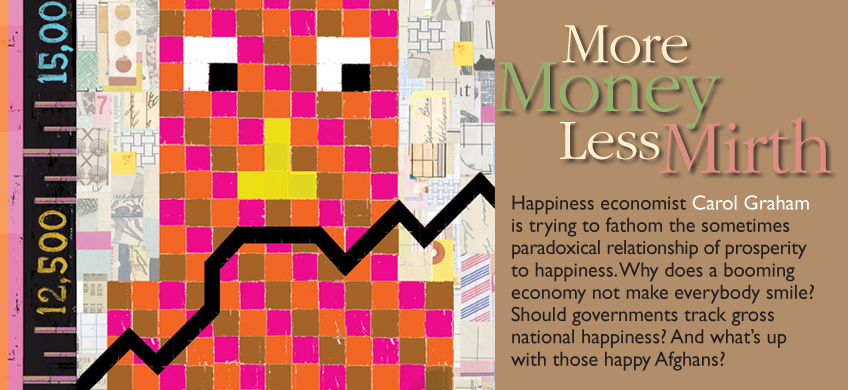
Carol Graham’s transition from Dr. Poverty to Dr. Happy began in the late 1990s when something she found in Peru did not make sense. Graham, SAIS ’86, was born in Lima in 1962, and spent so much time there as a child that she sometimes says “we” when speaking of Peruvians. (Her father, George C. Graham, founded a research institute for malnourished infants in Lima while on the faculty of the Bloomberg School of Public Health.) As a development economist at the Brookings Institution, she studied inequality in poor countries. She says, “I was always puzzled by why inequality seemed to create deep unrest and unhappiness in some contexts and not in others. What does it mean to people?” Peru was one locus of her work. In the late 1980s, hyperinflation and a deep recession ravaged the country. From 1988 to 1990, Peru’s gross domestic product fell by about 25 percent; by 1990, poverty affected 54 percent of the population. But four years later, Peruvians had turned their fortunes around and created what was then the world’s fastest-growing economy. Near the end of the 1990s, when Graham reviewed objective economic data, she found the boom still booming sufficiently for Peruvians to have more economic mobility than Americans.
Now for the part that didn’t make sense. According to standard economic theory, Peruvians were striving for utility—which is how an economist says “satisfaction gained from consumption”—and achieving it. The country’s soaring GDP translated to more utility and that, said conventional wisdom, should have meant lots of smiling, happy Peruvians. Yet when Graham went to Peru and interviewed people who had been the subjects in the original objective surveys—that is, when she gathered new subjective data simply by asking them if they were happy—Peruvians told a different story. Sure, they said, they were making more money. But when asked to compare their present to their past, more than half of those who had experienced the most upward mobility characterized their situations as either “negative” or “very negative.” Says Graham, “The people who had done the best were saying their situation was bad, or at least half of them were.”
Peru seemed chockablock with what Graham calls frustrated achievers. They reported less overall satisfaction, more fear of unemployment, and more concern with relative income differences than before the boom. She and her collaborator, Stefano Pettinato, now a policy adviser for the United Nations Development Programme, repeated the survey several years in a row and got the same results every year. Says Graham, “I thought, ‘Maybe it’s Peruvians. Maybe we’re just weird.’” But when she and Pettinato surveyed Russians, another people experiencing a rapidly expanding economy and lots of new opportunity, they found the same thing. Many Russians achieving the biggest economic gains reported that their new prosperity had not made them happy. They said they actually felt worse.
Graham could not explain this by any conventional economic model, so she began to review the happiness literature. Yes, economics, the “dismal science,” has a happiness literature, produced by an emerging subdiscipline called simply “happiness economics.” Graham found this line of inquiry—which often combines economics with methodologies from other social sciences, especially psychology—to her liking. For the last 10 years she has traveled the world, an economics naturalist studying people in their consumer habitats and mapping the intersection of economic theory and what actually seems to make people happy. She frequently finds paradoxes that belie long-held assumptions of economists. Begin with those more-prosperous-less-happy Russians and Peruvians, for example. The cause of their disgruntlement wasn’t more money—they didn’t object to that—but the rapid and unpredictable change that came with it. “People can be happy in the midst of unpleasant certainty,” Graham says. “Uncertainty is unsettling and that makes people unhappy.” Under the old Soviet system, most Russians were not materially well off, but they could count on tomorrow being pretty much like today. When the Soviet Union collapsed and a new Russian market economy lurched into gear, who knew what tomorrow would be like? For many Russians, more rubles did not soothe their anxiety about this new, disorienting world.
Graham, a thin, intense woman who conveys the impression of really, really enjoying her work, can happily reel off a list of similarly unanticipated findings. For example, people in Afghanistan, living in an impoverished, corrupt nation plagued by 30 years of continuous warfare, report levels of happiness higher than the global average. When the Japanese quintupled their income from 1958 to 1986, their happiness declined. The prosperous French seem not much happier than the comparatively poor Guatemalans. Outside Africa, optimism correlates with income. Within Africa, the most optimistic people are the poor. Not a few of happiness economists’ findings could fall under the heading Go Figure.
Illustration by Noha Woods
